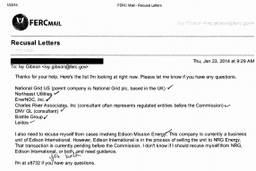For FERC’s Sake, Regulate
The most important government agency you’ve never heard of has never met a fracking lobbyist it didn’t like.
Justin Mikulka

“In the energy world, FERC regulates ‘midstream everything.’ ”
So said Alaska Sen. Lisa Murkowski ® in a July 2014 floor speech, answering her own question about why nominations to the little-known Federal Energy Regulatory Commission mattered. “Midstream,” in energy parlance, is the business of getting energy from where it is produced to where it is used. FERC’s purview of “midstream everything” includes oil and gas pipelines and storage facilities — infrastructure that is experiencing rapid growth, thanks to the shale oil and gas boom driven by hydraulic fracturing, aka fracking. There is a lot more energy to move around, and if you want to build new infrastructure to move it, you need FERC’s permission.
FERC has a longstanding reputation as an industry-friendly agency. As then-Governmental Affairs Committee Chairman Joe Lieberman observed in a scathing report after the Enron collapse in 2002, “Oftentimes, FERC seemed to view itself not as a regulator but as a facilitator — not as a market cop, but as a market cheerleader.” As the main government body charged with regulating Enron, FERC exhibited “a shocking absence of regulatory vigilance,” the report concluded, as well as an ironic failure “to meet the demands of the new, market-based system that the agency itself has championed.”
The makeup of today’s FERC suggests little has changed. Two of the five commissioners, Cheryl LaFleur and Philip Moeller, are former energy company executives — at National Grid and Alliant Energy, respectively. Two others, Colette Honorable and Tony Clark, are former heads of state public service commissions, bodies that are notoriously captive to the public utility companies they oversee. (A former head of Florida’s Public Service Commission once described it as “a wholly-owned subsidiary of the state’s biggest power companies.”) The only commissioner without a history of industry connections is Norman Bay, previously director of FERC’s Office of Enforcement and before that, a law professor.
Murkowski, a longtime champion of the oil and gas industry (and now chair of the Energy and Natural Resources Committee) has made it her business to keep on top of FERC nominations. In 2013, she led GOP efforts against Ron Binz, President Obama’s nominee for an open seat. A Wall Street Journal editorial opposing the nomination called Binz “the most important and radical Obama nominee you’ve never heard of.” What were the radical views that Binz espoused? Bloomberg reported that the senators leading the charge were “concerned Binz would support renewable energy at the expense of coal.” He was also on the record saying he believes in climate change. He ended up withdrawing his name.
Climate-change avoiders
While current FERC Chair Cheryl LaFleur (former acting CEO of National Grid) hasn’t denied the existence of climate change, she has told the energy website E&E News that there’s no good way to measure the environmental effects of greenhouse gases from pipelines or liquefied natural gas (LNG) export terminals. EPA spokesperson Monica Lee disagreed, noting the existence of “many well-developed tools for estimating greenhouse gas emissions from projects, which agencies, including FERC, can draw on in considering environmental impacts.”
FERC’s unwillingness to look at climate impacts — despite being required to do so by the National Environmental Policy Act — is what concerns environmental groups who are trying to stem a tide of proposed multi-billion-dollar LNG export facilities to handle all the fracked shale gas. While industry touts natural gas as a clean alternative energy, opponents cite a Department of Energy study that found the climate impact of exporting U.S. natural gas to Asian markets the same as if those markets continue to use coal. A total of 14 proposals for LNG export terminals had been submitted to FERC as of February. Before construction can begin, however, they require FERC’s stamp of approval. So far, FERC has approved four and has yet to deny any.
In October, FERC approved a controversial gas storage facility to be built in a former salt mine cavern along Seneca Lake in the town of Reading in upstate New York. What worries activists is the prospect of salt cavern collapses, like the one in Bayou Corne, Louisiana, that caused a 32-acre sinkhole. Activists believe that storing methane in crumbling salt caverns along the lake could result in a cavern collapse or in leaks that could contaminate the lake, a source of drinking water for 100,000 people.
“Without question, [FERC is] refusing to do any kind of serious analysis on the greenhouse gas implications or the climate implications of these decisions,” says Ted Glick, national campaign coordinator for the Chesapeake Climate Action Network (CCAN). In September, FERC greenlit Dominion Resources’ controversial expansion to its Cove Point LNG export facility on the shores of the Chesapeake Bay in Maryland.
Like other anti-fracking groups, CCAN is desperate to shine a light on the role played by FERC. CCAN and other groups making up the Beyond Extreme Energy network blockaded the entrance to FERC’s offices in Washington, D.C. last summer and fall, resulting in the arrest of more than 90 protesters.
In the courts, CCAN plans to join Earthjustice in a lawsuit challenging the Cove Point approval. However, Carolyn Elefant, a one-time FERC employee and now an independent lawyer who has represented clients challenging FERC decisions, is blunt in assessing the odds of such suits: “The cases are very difficult to win.”
Whatever the market wants
FERC is unusual among regulatory agencies in considering itself a booster of economic growth. The commission’s 2014 strategic plan includes “foster[ing] economic and environmental benefits for the nation through approval of natural gas and hydropower projects.”
To show the economic benefits of a project, a petitioner need only present FERC with buyers. As Chairman LaFleur has said, “We evaluate the need for the project based on market demand. Do they have people signing up for the gas?” In the case of Cove Point, those contracts were with companies in Japan and India eager to import natural gas.
Elefant says that FERC tends to assume from the outset that projects are justified. “They presume, ‘Why else would a company pursue a project if they didn’t think they could make money off of it?’ And that is the bottom line,” Elefant tells In These Times. “The presumption is that a pipeline company or a larger company is going to have resources and smart people that are going to get the right results.”
A revolving door
FERC’s faith in the energy industry is grounded in its cozy relationships. Ted Glick of CCAN, who has attended five FERC meetings since 2013, describes an “old boys’ club” atmosphere in which oil and gas industry reps joke and chat with commissioners. “It’s just palpable,” he says.
Some of the commissioners may be chatting with future employers. “Anyone who is a commissioner can have their pick of what they want to do next,” explains Elefant. For former FERC commissioner Suedeen Kelly, that meant leaving FERC for megalaw firm Patton Boggs LLP, which advises clients on FERC compliance, before joining the high-profile D.C. lobbying firm Akin Gump (dubbed K Street’s “top dog” last year by Politico). Kelly’s two terms as a FERC commissioner are mentioned many times on the Akin Gump website, and she leads an energy team that includes several other former FERC employees.
Likewise, Van Ness Feldman, the firm representing Dominion on the Cove Point project, is home to Robert Nordhaus, a former FERC general counsel. NextEra, one of the utility companies cited in a Forbes article about the regulatory capture of the Florida Public Service Commission, employs a former FERC chairman. The list goes on and on. The most recent FERC alum to make the jump was Robin Lunt, who left the commission in February to join the energy giant Innovari as a general counsel.
Further evidence of the tight relationship between FERC and the natural gas industry emerged in March when FERC hired Tetra Tech, a member of the gas industry lobbying group Marcellus Shale Coalition, to do the environmental analysis for the proposed PennEast natural gas pipeline. The coalition’s wholesale support of natural gas projects is expressed in a January 2013 letter from Marcellus Shale CEO Kathryn Klaber to U.S. Secretary of Energy Steven Chu, which suggests “moving forward with approval of all pending LNG export applications.”
The hiring of Tetra Tech to conduct the review has understandably angered activists. New Jersey Sierra Club Director Jeff Tittel described the choice as “an outrageous conflict of interest.”
Accustomed to being close to industry but distant from the public, FERC seems discomfited at the attention from environmentalists. In January, Chair LaFleur told the National Press Club, “These groups are active in every FERC docket, as they should be, as well as in my email inbox seven days a week, in my Twitter feed, at our open meetings demanding to be heard, and literally at our door closing down First Street so FERC won’t be able to work. We have a situation here.”
Protesters and members of the Beyond Extreme Energy network are pushing for that situation to change — to one in which FERC gives as much consideration to citizens and the environment as it currently does to industry.






